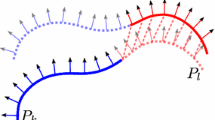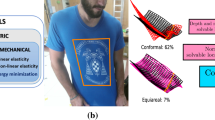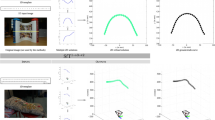Abstract
Although the 3D orientations of edges and surfaces are theoretically sufficient for reconstructing the 3D object shape, this does not mean that the 3D object shape can actually be reconstructed. Specifying the edge and surface orientations is often overspecification, and inconsistency may result if image data contain errors. We propose a scheme of optimization to construct a consistent polyhedron shape from inconsistent data. Our optimization is achieved by solving a set of linear equations; no searchers and iterations are necessary. This technique is first applied to the problem of shape-from-motion and then to the 3D recovery based on the rectangularity hypothesis and the parallelism hypothesis. We also present a strategy of heuristic reasoning on rectangularity and parallelism.
Similar content being viewed by others
References
J. Y. Aloimonos and M. Swain, “Shape from patterns: Regularization”, Intern. J. Comput. Vision 2(2): 171–187, 1988.
S.T. Barnard, “Choosing a basis for perceptual space”, Comput. Vision Graphics Image Process. 29:87–99, 1985.
B.F. Buxton and H. Buxton, “Monocular depth perception from optical flow by space time signal processing”, Proc. Roy. Soc. London B218:27–47, 1983.
B.F. Buxton, D.W. Murray, H. Buxton and N.S. Williams, “Structure-from-motion algorithms for computer vision on an SIMD architecture”, Comput. Phys. Comm. 37:273–280, 1985.
M.B. Clowes, “On seeing things”, Artificial Intelligence 2:79–116, 1971.
R.T. Frankot and R. Chellapa, “A method for enforcing integrability in shape from shading algorithms”, IEEE Trans. PAMI 10(4): 439–451, 1988.
R.M. Haralick, “Using perspective transformations in scene analysis”, Comput. Graphics Image Process. 13:191–221, 1980.
B.K.P. Horn and M.J. Brooks, “The variational approach to shape from shading”, Comput. Vision Graphics Image Process. 33:174–208, 1986.
D.A. Huffman, “Impossible objects as nonsense sentences”, Machine Intelligence, vol. 6 (eds. B. Meltzer and D. Michie). Edinburgh Univ. Press: Edinburgh, U.K., pp. 295–323, 1971.
K. Kanatani, “The constraints on images of rectangular polyhedra”, IEEE Trans. PAMI 8(2):456–463, 1986.
K. Kanatani, “Structure and motion from optical flow under orthographic projection”, Comput. Vision Graphics Image Process. 35:181–199, 1986.
K. Kanatani, “Structure and motion from optical flow under perspective projection”, Comput. Vision Graphics Image Process. 38:122–146, 1987.
K. Kanatani, “Coordinate rotation invariance of image characteristics for 3D shape and motion recovery”, Proc. 1st Int. Conf. Comput. Vision, London, pp. 55–64, June 1987.
K. Kanatani, “Camera rotation invariance of image characteristics”, Comput. Vision Graphics Image Process. 39:328–354, 1987.
K. Kanatani, “Constraints on length and angle”, Comput. Vision Graphics Image Process. 41:28–42, 1988.
K. Kanatani, “Transformation of optical flow by camera rotation”, IEEE Trans. PAMI 10:131–143, 1988.
J.J. Koenderink and A.J. van Doorn, “Invariant properties of the motion parallax field due to the movement of rigid bodies relative to an observer”, Optica Acta 22:773–791, 1975.
J.J. Koenderink and A.J. van Doorn, “Local structure of movement parallax of the plane”, J. Opt. Soc. Am. 66:717–723, 1976.
H.C. Longuet-Higgins, “A computer algorithm for reconstructing a scene from two projections”, Nature 293:133–135, 1981.
H.C. Longuet-Higgins, “The visual ambiguity of a moving plane”, Proc. Roy. Soc. London B 223:165–175, 1984.
H.C. Longuet-Higgins and K Prazdney, “The interpretation of a moving retinal image”, Proc. Roy. Soc. London B 208:385–397, 1980.
A.K. Mackworth, “Model-driven interpretation in intelligent vision system”, Perception 5:349–370, 1976.
M.J. Magee and J.K. Aggarwal, “Determining vanishing points from perspective images”, Comput. Vision Graphics Image Process. 26:256–267, 1984.
D. Marr, Vision: A Computational Investigation into the Human Respresentation and Processing of Visual Information, Freeman: San Francisco, 1982.
P.G. Mulgaonkar, L.G. Shapiro, and R.M. Haralick, “Shape from perspective: A rule-based approach”, Comput. Vision Graphics Image Process 36:298–320, 1986.
S. Negahdaripour and B.K.P. Horn, “Direct passive navigation”, IEEE Trans. PAMI 9(1):168–176, 1987.
T. Poggio and C. Koch, “Ill-posed problems in early vision: From computational theory to analogue networks”, Proc. Roy. Soc. London B 226:303–323, 1985.
T. Poggio, V. Torre, and C. Koch, “Computational vision and regularization theory”, Nature 317(26):314–319, 1983.
A.N. Tikhonov and V.Y. Arsenin, Solutions of Ill-posed Problems, Winston: Washington, DC, 1977.
S.B. Pollard, J. Porrill, J.E.W. Mayhew, and J.P. Frisby, “Matching geometrical descriptions in three-space”, Image Vision Computing 5:73–78, 1987.
J. Porrill, S.B. Pollard, and J.E.W. Mayhew, “Optimal combination of multiple sensors including stereo vision”, Image Vision Computing 5:174–180, 1987.
T. Shakunaga and H. Kaneko, “Perspective angle transformation and its application to 3-D configuration recovery”, Proc. IEEE Conf. Comput. Vision Pattern Recog., Miami Beach, FL, pp. 594–601, June 1986.
M. Subbarao and A.M. Waxman, “Closed form solution to image flow equations for planar surface in motion”, Comput. Vision Graphics Image Process. 36:208–228, 1986.
M. Subbarao, “Interpretation of image flow: Rigid curved surfaces in motion”, Intern. J. Comput. Vision. 2:77–96, 1988.
K. Sugihara, “Mathematical structures of line drawing of polyhedrons-toward man-machine communication by means of line drawings”, IEEE Trans. PAMI 4:458–469, 1982.
K. Sugihara, “A necessary and sufficient condition for a picture to represent a polyhedral scene”, IEEE Trans. PAMI 6:578–586, 1984.
K. Sugihara, “An algebraic approach to shape-from-image problems”, Artificial Intelligence 23:59–95, 1984.
K. Sugihara, Machine Interpretation of Line Drawings, MIT Press: Cambridge, MA, 1986.
R.Y. Tsai and T.S. Huang, “Uniqueness and estimation of three-dimensional motion parameters of rigid objects with curved surfaces”, IEEE Trans. PAMI 6(1):13–27, 1984.
A.M. Waxman and S. Ullman, “Surface structure and three-dimensional motion from image flow kinematics”, Intern. J. Robotics Res. 4:72–94, 1985.
A.M. Waxman and K. Wohn, “Contour evolution, neighborhood deformation and global image flow: Planar surfaces in motion”, Intern. J. Robotics Res. 4:95–108, 1985.
Author information
Authors and Affiliations
Rights and permissions
About this article
Cite this article
Kanatani, K. Reconstruction of consistent shape from inconsistent data: Optimization of \(2{\raise0.5ex\hbox{$\scriptstyle 1$}\kern-0.1em/\kern-0.15em\lower0.25ex\hbox{$\scriptstyle 2$}}\)D sketches. Int J Comput Vision 3, 261–292 (1989). https://doi.org/10.1007/BF00132600
Issue Date:
DOI: https://doi.org/10.1007/BF00132600




